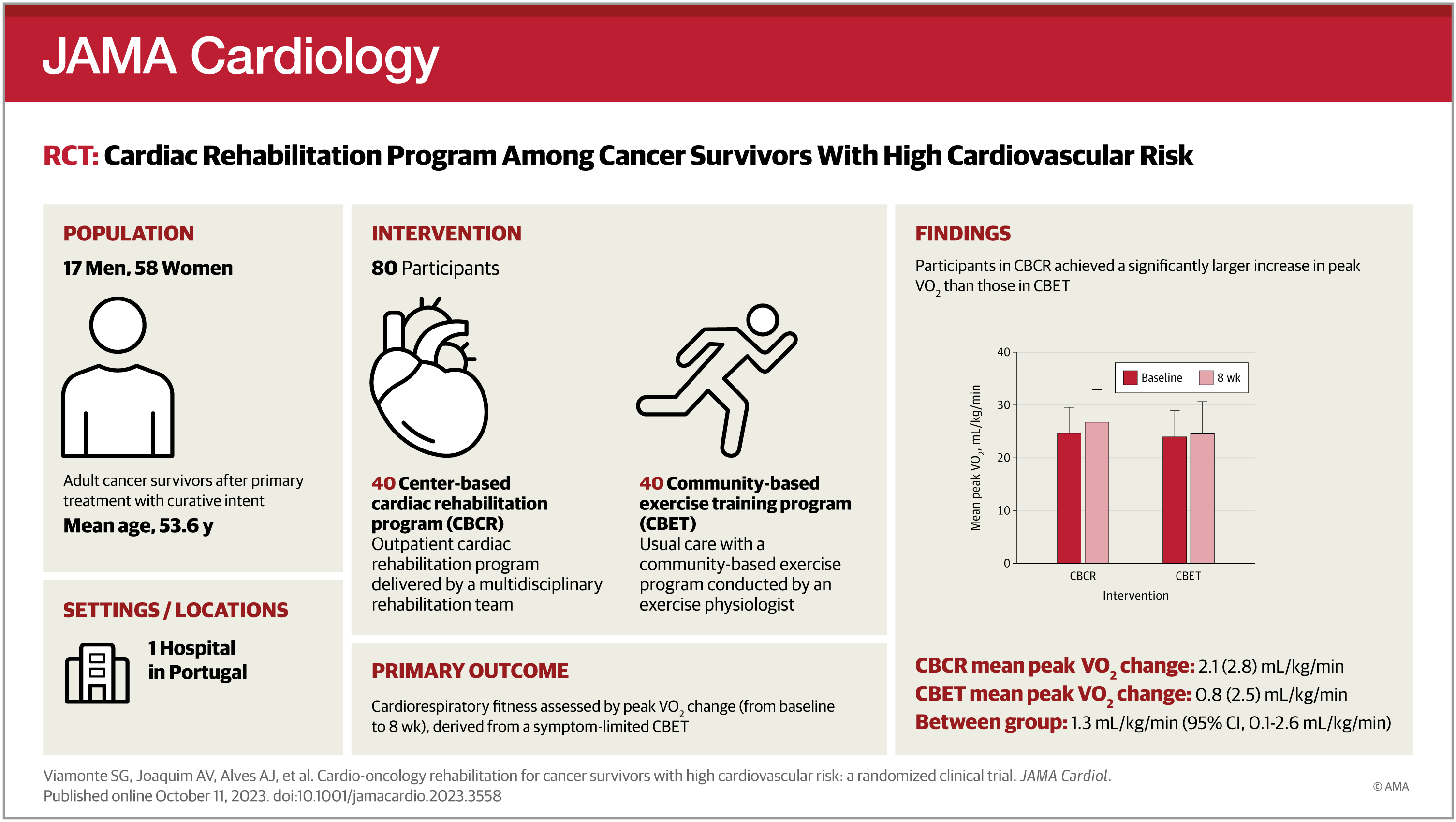Cardiovascular
Cardio-Oncology Rehabilitation for Cancer Survivors With High Cardiovascular Risk
Key Points
Question
Does a structured and supervised cardio-oncology rehabilitation program improve cardiorespiratory fitness compared with a community-based exercise intervention?
Findings
In this randomized clinical trial including 75 cancer survivors with high cardiovascular risk, an 8-week cardio-oncology rehabilitation framework promoted superior, clinically meaningful improvements in peak oxygen consumption.
Meaning
The findings suggest that a cardio-oncology program is effective and has the potential within the established infrastructure of cardiac rehabilitation to be incorporated in the standard care of this population with complex and challenging needs.
Importance
Cardiovascular disease is a leading cause of morbidity in cancer survivors, which makes strategies aimed at mitigating cardiovascular risk a subject of major contemporary importance.
Objective
To assess whether a center-based cardiac rehabilitation (CBCR) framework compared with usual care encompassing community-based exercise training (CBET) is superior for cardiorespiratory fitness improvement and cardiovascular risk factor control among cancer survivors with high cardiovascular risk.
Design, Setting, and Participants
This prospective, single-center, randomized clinical trial (CORE trial) included adult cancer survivors who had exposure to cardiotoxic cancer treatment and/or previous cardiovascular disease. Enrollment took place from March 1, 2021, to March 31, 2022. End points were assessed at baseline and after the 8-week intervention.
Interventions
Participants were randomly assigned in a 1:1 ratio to 8 weeks of CBCR or CBET. The combined aerobic and resistance exercise sessions were performed twice a week.
Main Outcomes and Measures
The powered primary efficacy measure was change in peak oxygen consumption (V̇o2) at 2 months. Secondary outcomes included handgrip maximal strength, functional performance, blood pressure (BP), body composition, body mass index (BMI; calculated as weight in kilograms divided by height in meters squared), lipid profile, plasma biomarker levels, physical activity (PA) levels, psychological distress, quality of life (QOL), and health literacy.
Results
A total of 75 participants completed the study (mean [SD] age, 53.6 [12.3] years; 58 [77.3%] female), with 38 in the CBCR group and 37 in the CBET group. Participants in CBCR achieved a greater mean (SD) increase in peak V̇o2 than those in CBET (2.1 [2.8] mL/kg/min vs 0.8 [2.5] mL/kg/min), with a between-group mean difference of 1.3 mL/kg/min (95% CI, 0.1-2.6 mL/kg/min; P = .03). Compared with the CBET group, the CBCR group also attained a greater mean (SD) reduction in systolic BP (−12.3 [11.8] mm Hg vs −1.9 [12.9] mm Hg; P < .001), diastolic BP (−5.0 [5.7] mm Hg vs −0.5 [7.0] mm Hg; P = .003), and BMI (−1.2 [0.9] vs 0.2 [0.7]; P < .001) and greater mean (SD) improvements in PA levels (1035.2 [735.7] metabolic equivalents [METs]/min/wk vs 34.1 [424.4] METs/min/wk; P < .001), QOL (14.0 [10.0] points vs 0.4 [12.9] points; P < .001), and health literacy scores (2.7 [1.6] points vs 0.1 [1.4] points; P < .001). Exercise adherence was significantly higher in the CBCR group than in the CBET group (mean [SD] sessions completed, 90.3% [11.8%] vs 68.4% [22.1%]; P < .001).
Conclusion and Relevance
The CORE trial showed that a cardio-oncology rehabilitation model among cancer survivors with high cardiovascular risk was associated with greater improvements in peak V̇o2 compared with usual care encompassing an exercise intervention in a community setting. The CBCR also showed superior results in exercise adherence, cardiovascular risk factor control, QOL, and health literacy.
Trial Registration
ClinicalTrials.gov Identifier: NCT05132998

